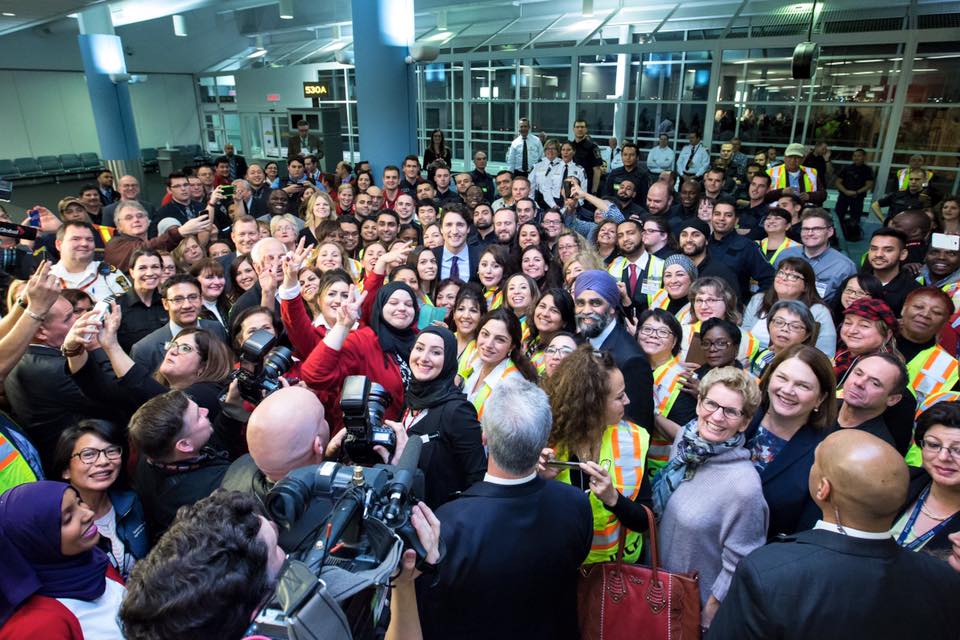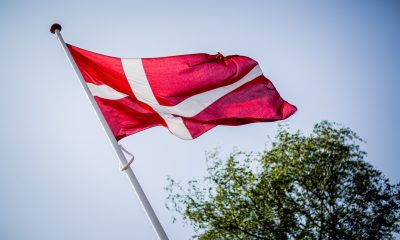Immigration
A timeline of Canada’s policies and decisions during the Syrian refugee crisis

Syrian refugees welcomed in Canada last year.
(Photo from Prime Minister Trudeau’s official Facebook page)
OTTAWA—Immigration Minister John McCallum is easing restrictions on the private sponsorship of Syrian refugees, adding thousands to the number of refugees arriving this year. Here is a timeline of how private sponsors have responded to the Syrian refugee crisis.
2011:
The Syrian civil war breaks out, triggering a wave of migration and displacement that has to date created an estimated 4.2 million Syrian refugees and sent millions more fleeing for safety.
2012:
Groups in Canada call on the government to do more to assist displaced Syrians, including making it easier for Syrians already in Canada to bring family members and speeding up asylum claim processing for those already in Canada.
The Conservative government says it won’t resettle refugees from Syria until the UN makes a formal request.
The Conservatives make changes to refugee policy that make it more challenging for certain private groups, known as groups of five, to sponsor refugees by requiring a sponsored individual be officially registered as a refugee by the UN. They say the move is meant to cut down on fraud and help bring down existing wait times.
The government closes the embassy in Damascus, forcing those immigration cases—Including thousands of Iraqis—to be shuffled around the Middle East. Wait time for privately sponsored files out of that region begin to increase.
2013:
The UN makes its first formal request for states to resettle Syrian refugees. In July, Canada agrees to take in 1,300 by the end of 2014 using the 200 government-assisted refugee spots set aside for emergency resettlement requests and opening up the rest for private sponsorship.
Private sponsors are forced to scramble to raise the necessary funds, find refugees to sponsor and file the paperwork. Between July and December of 2013, they submit 195 applications.
2014:
The Conservatives come under fire amid fear they will miss their Syrian refugee targets. The average processing time for privately sponsored refugee applications out of Lebanon, temporary home to one million Syrian refugees, was two years.
By year-end, only 1,063 Syrian refugees have arrived in Canada, with more being government assisted than planned in order for the government to make any progress towards its target.
In total in 2014, 1,299 applications were received by private groups interested in sponsoring Syrians.
2015:
January: Conservatives commit to resettling a further 10,000 Syrian refugees and suggest they’ll again look to private sponsors to take in 60 per cent.
March: The government finally meets its 2013 promise, with 434 government-assisted refugees and 866 privately sponsored refugees in Canada.
June: A group called Lifeline Syria launches in Toronto with the goal of getting 1,000 Syrian refugees to Canada via the private sponsorship program.
July: The UN estimates the number of Syrian refugees has surpassed four million. Hundreds of thousands of others begin making their way out of Syria and surrounding countries in search of safe haven in Europe.
September: Three-year-old Alan Kurdi drowns as his family attempts to flee. It emerges Kurdi had relatives in Canada who had made an application to bring over Alan’s uncle, but were rejected. Postmedia reports the rejection was the result of the Conservative rule changes for groups of five in 2012.
The Conservatives exempt Syrian and Iraqi applications from the group of five rule and add staff to visa processing points in a bid to bring down wait times in response to public demand.
All three main federal parties make election campaign commitments to increase intake. The Liberals promise to bring in 25,000 Syrians immediately and work with the private sector to do more.
October: Interest in private sponsorship of Syrians spikes—551 applications are received, the highest single-month total so far that year.
November: The Liberals take office and roll out their marquee plan to get 25,000 Syrians to Canada by the end of February. The initial target was 10,000 privately sponsored refugees.
Between Jan. 1, 2015, and Dec. 14, 2015, 3,700 private sponsorship applications for Syrians are submitted, representing just over 8,214 people. By Dec. 31, 3,067 privately sponsored Syrians have arrived in Canada.
2016:
January: The Liberals decide to cap on the number of applications they’ll accept in 2016 to sponsor Syrians, folding them into the global plan for private sponsor settlement. The cap applies to any application received as of Jan. 1.
February 27: The Liberals reach their goal to settle 25,000 people. Privately sponsored Syrians account for 8,792.
The Liberals close up the major processing centres in Jordan and Lebanon and scale back the number of staff processing applications in Winnipeg.
Mar. 2: The Liberals confirm privately sponsored refugees who arrive in Canada after that date will be responsible for the cost of their own flights and medical exams. Under the Liberals’ special resettlement program for Syrians, those costs had been waived.
March 14: There are just over 6,600 private applications in the inventory. Sponsorship groups get wind of the changes and begin to voice their displeasure when they realize the families they are seeking to sponsor won’t arrive until 2017.
Mar. 31: Immigration Minister John McCallum announces any applications received before that day will be exempt from the cap and should be processed fast enough to see the Syrians arrive this year or early in 2017.























